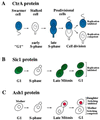Controlling cell cycle and cell fate: common strategies in prokaryotes and eukaryotes
- PMID: 9419330
- PMCID: PMC34196
- DOI: 10.1073/pnas.95.1.85
Controlling cell cycle and cell fate: common strategies in prokaryotes and eukaryotes
Figures

Similar articles
-
Programming of cell polarity in budding yeast by endogenous and exogenous signals.Cold Spring Harb Symp Quant Biol. 1995;60:717-27. doi: 10.1101/sqb.1995.060.01.078. Cold Spring Harb Symp Quant Biol. 1995. PMID: 8824447 Review. No abstract available.
-
Choreographing the bacterial cell cycle.Science. 1996 Jan 19;271(5247):291. doi: 10.1126/science.271.5247.291. Science. 1996. PMID: 8553061 No abstract available.
-
Rme1, which controls CLN2 expression in Saccharomyces cerevisiae, is a nuclear protein that is cell cycle regulated.Mol Genet Genomics. 2001 Nov;266(3):374-84. doi: 10.1007/s004380100515. Mol Genet Genomics. 2001. PMID: 11713667
-
The ins and outs of cell-polarity decisions.Nat Cell Biol. 2000 Mar;2(3):E39-41. doi: 10.1038/35004065. Nat Cell Biol. 2000. PMID: 10707093
-
Building organs and organisms: elements of morphogenesis exhibited by budding yeast.Cold Spring Harb Symp Quant Biol. 1997;62:57-63. Cold Spring Harb Symp Quant Biol. 1997. PMID: 9598336 Review. No abstract available.
Cited by
-
Cyclin-dependent kinases and cell division in plants- the nexus.Plant Cell. 1999 Apr;11(4):509-22. doi: 10.1105/tpc.11.4.509. Plant Cell. 1999. PMID: 10213774 Free PMC article. No abstract available.
-
Temporal controls of the asymmetric cell division cycle in Caulobacter crescentus.PLoS Comput Biol. 2009 Aug;5(8):e1000463. doi: 10.1371/journal.pcbi.1000463. Epub 2009 Aug 14. PLoS Comput Biol. 2009. PMID: 19680425 Free PMC article.
-
An ensemble learning approach to reverse-engineering transcriptional regulatory networks from time-series gene expression data.BMC Genomics. 2009 Jul 7;10 Suppl 1(Suppl 1):S8. doi: 10.1186/1471-2164-10-S1-S8. BMC Genomics. 2009. PMID: 19594885 Free PMC article.
-
His kinase or mine? histidine kinases through evolution.J Biosci. 2000 Dec;25(4):317-22. doi: 10.1007/BF02703784. J Biosci. 2000. PMID: 11120583 Review. No abstract available.
References
Publication types
MeSH terms
Substances
LinkOut - more resources
Full Text Sources
Molecular Biology Databases

